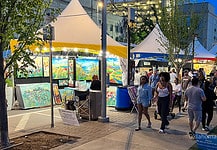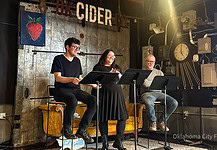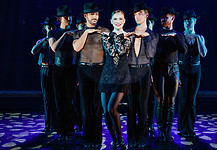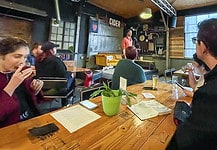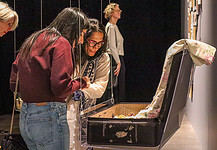Last Updated on November 27, 2021, 9:58 AM | Published: November 25, 2021
OKLAHOMA CITY (Free Press) — From gigantic flowers to moving historical tributes, Oklahoma City’s edifices have turned into a monument to the plural and free expression of her mural artists.
Ten years ago, or even five, the concept of Oklahoma City as something other than the prairie remnants of an aged boomtown was idealistic; the possibility was contemplated, but never seriously considered.
Today, seismic shifts in the economic and cultural dynamic make it not only possible, but inevitable to consider Oklahoma City’s future as a vibrant hub for art, music, and the engines of pop culture.
Taking a bike tour around town (unthinkable a decade ago) with guides intimately acquainted with the city, like Ryan Fogle, reveal the physical dimensions of change that the city is experiencing.
Perhaps the greatest metric by which Oklahomans can measure this change is the dramatic boom in public art that has come to characterize the city, and in particular, the murals painted across town.
Stand-out
One mural, in particular, stands out for its magnitude and history. Jack Fowler’s OKCtopus dominates its host building, with its many tentacles wrapped across its wall like the mythical Kraken.
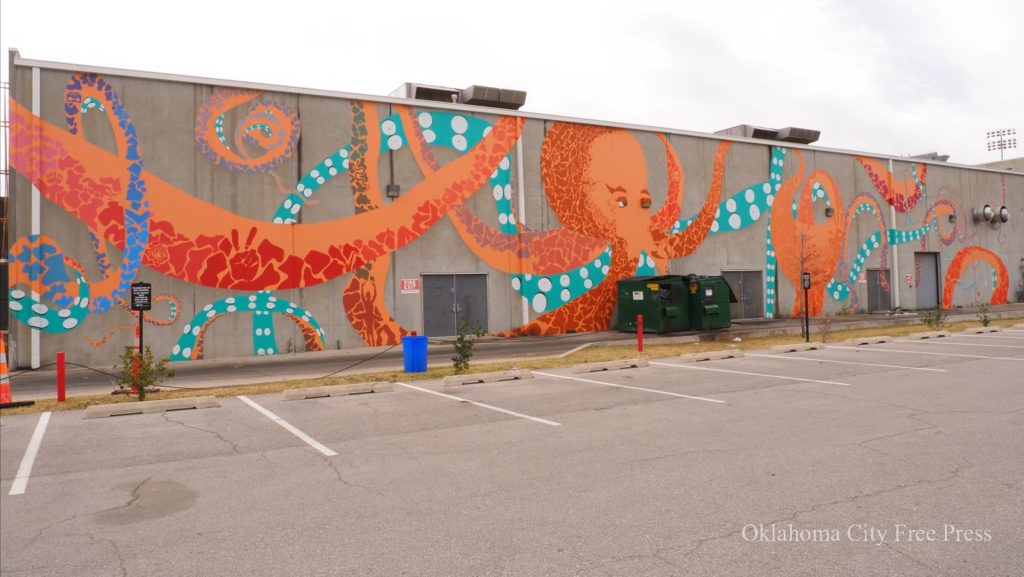
The inspiration for Fowler’s work, however, was his girlfriend.
After receiving an invitation from Downtown OKC to paint a mural on the abandoned Bricktown Event Center, Fowler drove out to see the building for himself. “I was standing in the back of that lot, looking at the back of that building – the shape of it is so long and low-swung – I was just trying to figure out what on earth can I put here, and my girlfriend was really into octopuses and I’d just been reading a lot about them lately – I just saw one snaking across this building, and after I saw that I never really saw anything else. That’s all I really needed to experience.”
After 35 days of work, Fowler completed the OKCtopus in December 2016. It represents the starting point for what has become many instances of creative public art throughout the City.
Fowler’s mural is dotted with hidden images – “Easter eggs” – that draw viewers’ attention across the wall.
Take a trip!
Go to the mural on the alley side of the Bricktown IHOP and the Bricktown Event Center to find it and use your phone for an augmented reality scavenger hunt of five of the hidden images. On each one, a pop-up will show Fowler talking about how he came up with that particular hidden image.
Tips:
- Be sure to give permission for Zappar to use your phone’s camera when it asks.
- Once looking through to the mural, tap on the “Press Here” button to get started.
- Just use your camera to scan the mural for each small image and it will give you a tone when it hits.
- Once you find all five, back up into the parking lot to give yourself a full view of the last surprise.
Once you have found five of them the sixth button will give you a motion view of the mural.
Scavenger hunt
The scavenger hunt forces an observer to slow down and appreciate the full breadth of the mural. Everything from a saxophone to a light bulb to an elephant is contained within the OKCtopus’s tentacles.

When asked why it was important to Fowler to include these hidden images, his response was simple: “it was too big!”
He points out that “it’s such a big piece that standing in front of it like if you were a pedestrian, you really can’t see it. It’s like observing a blue whale from six inches away: It doesn’t mean anything. So, I needed something to make it mean something to a person who was standing in front of it instead of a hundred yards away from it.”
By painting pieces within the larger mural, Fowler provides close-range observers with something active to view, “instead of something larger they couldn’t comprehend from their distance.” It also doubled to keep Fowler focused and inspired during what he called “a total endurance test for me.”
The sheer astounding size of the mural juxtaposed with the near-microscopic detail of the individual images makes clear why the mural was such a feat for Fowler.
Ordinance obstacle
But before Fowler’s brush could put paint to wall, another obstacle nearly ended the project as it began.
Oklahoma City had, according to Fowler, enforced an ordinance in Bricktown that prohibited any “non-historical art.” He was urged to turn instead to Charlie Christian, an Oklahoma City-based jazz musician of the Deep Deuce scene, by local journalists and others.
Fowler responded in the negative: “I don’t think artists work for the tourism bureau.” Downtown OKC supported Fowler and challenged the ordinance, eventually wiping it from the codebook of Oklahoma City.
Pathfinder
Fowler’s work paved the way for public art in Oklahoma City.
The growth of public art continues as an ongoing trend in Oklahoma City. “More and more landlords and property owners, I think, are realizing the benefit of not only painting on their building but letting artists use their buildings as studios while they’re not being used as anything else,” said Fowler.
Today, public art in Oklahoma City is one of its trademarks. “It’s sort of created a climate here, that I don’t think anybody could’ve predicted even twenty years ago: that this town would be sort of known for their murals and landlords being conducive to working with artists who want to make public art.”
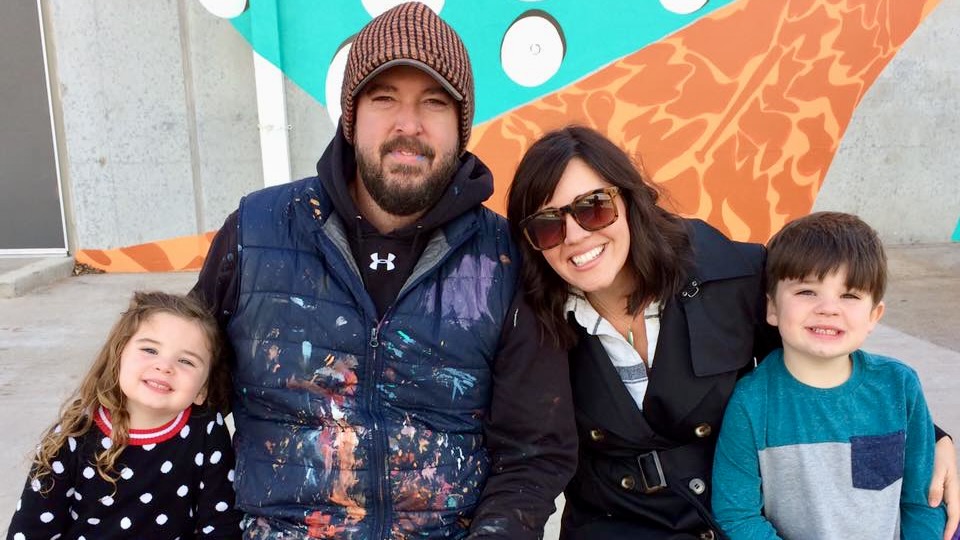
For Fowler, the value of public art and murals is twofold. “Painting art on the side of a building makes that building come alive in a way it just was not before, and that’s a contagious thing.”
Furthermore, murals and public art revitalize the abandoned and deserted parts of the city.
As Fowler points out, “if you are looking to start a business, or buy or sell a building, or even do day-to-day commerce, the way a place feels to you affects whether or not you’re going to do that.”
Investments in public art shape the community around it, bringing attention and ultimately economic resources to new and dynamic places in the city. The OKCtopus is just one example of the value public art has to Oklahoma City, and the need to continue supporting public artists as we reap the benefits of their work.
Special thanks to the Inasmuch Foundation for a grant that made it possible for us to partner with Trifecta Communications and create augmented reality features for this and two more future art reporting projects. Watch this space for future collaborations!
Devraat Awasthi is an art reporter for Free Press, a full-time law student at the University of Oklahoma, and is interested in pop culture’s role in public communities.



